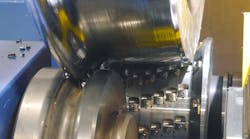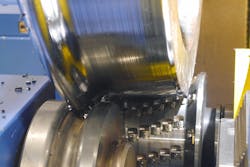Simmons Machine Tool Corp. in Albany, N.Y., designs and builds machine tools for railway wheel-set production and maintenance, and recognized a need for a new, five-axis mill-turn machine. Due to concerns about chip fall, robustness, accuracy, and consistency, many five-axis machines designed for tool and die mold applications failed to meet Simmons’ needs.
Machining for machine tools -- Given the heavy-duty nature of the work done by Simmons Machine Tool machines, and trend of operators forgoing preventative maintenance in favor of more durable machines, the products it develops must be exceptionally robust. To ensure reliability and durability for its customers, Simmons Machine Tool must have robust processes and machines for its own products.
All this gave Simmons’ leadership had a novel perspective on the purchasing process. They needed a five-axis machine to mill and turn precision parts, like profile milling cutters for underfloor wheel re-profiling machines. Over 12 years using various five-axis machines, they had come to realize that standard milling machines used in tool-and-die mold production were not up to producing hardened cutter bodies and similar robust tools and components.What’s more, as machine tool builders themselves, Simmons’ experts were able to evaluate machines in terms of fit and finish, chip evacuation and containment, etc. Finally, based on warranty claims and service calls from their own customers, Simmons knew to look at indirect performance factors and aspects of user experience that would determine a machine’s value throughout its service life.
Challenges of selecting a five-axis machine -- Simmons Machine Tool began searching for a new five-axis machine in 2016, to be used to produce profile milling cutters for in-situ wheel re-profiling. These cutters are milled and turned from a 12-in. diameter solid stock 4150 steel, hardened to about 300 BHN. Then, the cutters are used on Simmons’ Stanray machines, supplied to freight railway, metro, and transit passenger railway customers around the world.
At 22.5 tons, the Stanray machine is mounted in a pit under the rail so that a locomotive can be positioned on top of the machine. The profile milling cutters then re-profile the wheels, which often are in poor condition with flat spots on the tread caused by wheel slippage or emergency braking. The flat spots – work hardened areas about the size of a quarter – are far higher in measured hardness than the rest of the wheel surface.
“We reviewed several different five-axis machines, and most couldn’t keep up with the demands of our application,” said Simmons Machine Tool president/COO David William Davis. “We make a lot of chips when we make a cutter, so chip containment and evacuation from the machine tool is important, and many just didn’t measure up.”
The company found that five-axis machining centers with vertical spindle orientations tend to have more surfaces and areas where chips accumulate, which prevents easy chip evacuation. Additionally, many five-axis machines are focused on die and mold production rather than heavy-duty metal cutting, and so would hold up to the demanding railway machine application.
“Overall machine robustness and dependability also was an issue, primarily involving spindle bearing contamination and related failures,” Davis added. “Last, we found that with many five-axis machine builders, locally available service plus quality remote or virtual service, often simply was not available.”
Also, Simmons’ team were interested in flexible service and repair options, because they knew they would be able to fix some issues themselves with remote support.Finding a good fit -- Having rejected several five-axis machines, a Grob Systems representative presented a horizontal spindle five-axis universal mill-turn machine. Satisfied that one of these machines would be robust enough to meet its needs, and that Grob’s service offerings would be suitable, Simmons purchased a Grob G550T five-axis universal mill-turn machining center in spring 2017. The machine was put into full production late 2017 and Grob Systems in Bluffton, Ohio, oversaw training at the Albany plant.
“We knew that we wanted a production machine that was built ‘Stanray tough.’ We were aware of Grob from automotive, high-volume machining installations, as our sister companies in Germany build machine tools for manufacturing automotive crankshafts and other engine components,” Davis recalled. “Grob’s reputation as a reliable manufacturer of extremely dependable and robust machines in a demanding production environment was well-known to us.”
Simmons chose Grob’s five-axis machining technology because it was production ready, has a horizontal spindle configuration allowing for optimal chip flow, features intuitive programming, and delivers reliable consistency and accuracy. The Grob five-axis technology has been an excellent fit for Simmons’ demanding and precise manufacturing practices.
“We achieve better dimensional consistency with the G550T compared to other five-axis machines. As an example, one key dimension on the Stanray profile milling cutter has to be turned to +0.0000, -0.0005 in. After a short time using the G550T, we simply eliminated probing this feature because our confidence in hitting this dimension repeatedly is so high,” Davis said.
Part of the precision and accuracy benefits of the Grob machining center comes from its programming environment, which Davis said machinists have found to be very intuitive for five-axis machining.
The programming environment, specifically the Siemens NX CAM software paired with Siemens controls, allows machinists to simulate parts of a virtual machine. As a result, Simmons machinists report high levels of confidence in products machined by the G550T, even with first-of-its-kind parts.
One factor favoring the Grob five-axis machine was its horizontal spindle axis. “Before we decided to purchase the Grob product, we talked with other machine shops and manufacturers about whether a vertical or horizontal spindle orientation is better. Sometimes people are intimidated by a horizontal orientation, because it’s not as common in tool-and-die mold machining technology, but our machinists found there was little to no barrier to entry thanks to the digital tools that are part of Grob’s machine package,” Davis said.
“The horizontal spindle configuration, plus the overall design of the machining area, permits optimal chip flow and evacuation and unattended running, all of which are extremely important in our manufacturing processes.”
In addition, Simmons operators have found the Grob spindle to be extremely robust. The spindles are built by Grob and can be repaired or replaced easily, which may be critical to maintaining uptime.
Saving time, saving money -- Implementing Grob’s G550T five-axis machining technology has translated into cost savings and efficiency benefits over nearly three years for Simmons Machine Tool. Downtime has been reduced significantly compared to the previous five-axis machine, and the G550T’s design factors are contributing to manufacturing efficiency and cost optimization. And, the Grob machine can be operated unattended, saving man-hours, Davis reports. Simmons has exceeded its ROI goals over three years.
The G550T’s accuracy and consistency is such that individual components do not need to be measured for accuracy, thus reducing measuring time as well as non-value-added time in the production stream. More than this, reduced vibration at the tool tip is extending tool life and contributing to accurate and consistent performance.
Finally, Davis reports, Grob’s service team has consistently responded rapidly and, in most cases, has been able to service the machine remotely.








